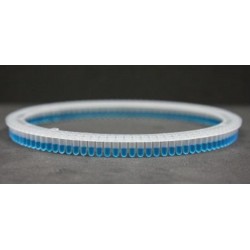Rotor Gene 6000 Software As A Service
A human A/T SNP in the AHRR7 gene was analyzed using genomic DNA from wild-type (blue), homozygous mutant (green), and heterozygous (red) samples. Experiments were performed using the Type-it HRM PCR Kit and a Rotor-Gene Q cycler with a HRM channel. Data analysis was performed with the unsupervised mode of Rotor-Gene ScreenClust HRM Software. A/T polymorphisms (class IV SNPs) are most difficult to discriminate due to minute differences between homozygote alleles (in this example, less than 0.1°C). [ A] HRM raw data, [ B] the normalized melting curve, [ C] the residual plot, and [ D] the cluster plot are shown. All pseudo-unknowns were correctly clustered according to genotype. Gene mutations (insertions/deletions) in EGFR exon 19 were analyzed using Rotor-Gene ScreenClust HRM Software in supervised mode.
How to start a RotorGene run. Start the Rotor-Gene software. Choose: Advanced/ Perform Last Run and press New. Setup and analysis RotorGene 3000_6000_Q – v4. Mitek 20 20 Software. Read independent reviews on Rotor-Gene™ 6000 - the future of real-time genetic analysis from QIAGEN on SelectScience. Software: Hailed as the best.
Experiments were performed using the Type-it HRM PCR Kit, a Rotor-Gene Q cycler with a HRM channel, and plasmid DNA templates. [ A] A normalized melt plot shows very similar curve shape with only minute differences in melting points, making genotyping challenging. [ B- D] Cluster plots using 3 principal components show the correct assignment of 6 different mutations and the wild type sample: M1: c.2235_2249del15, M3: c.2237_2252del16insT, c.2237_2238ins18, M4: c.2237_2238ins18, M5: c.2239_2248del10insC, M6: c.2240_2254del15, M7: c.2240_2257del18. These Rotor-Gene Q cycler, in combination with Rotor-Gene ScreenClust HRM Software, enables identification of even difficult class IV A/T SNPs which can have differences in melting temperatures as low as 0.1°C (see figure '). In this mutation detection experiment, various gene mutations resulting form insertions/deletions in the EGFR gene exon 19 were analyzed (see figure '). Rotor-Gene ScreenClust HRM Software accurately separated multiple close and partially overlapping melt profiles by successfully extracting data characteristics into the 3 first principal components. All 6 pseudo-unknowns and the wild-type sample were correctly identified.

HRM is an innovative technique that characterizes double-stranded PCR products based on their melting (dissociation) behavior as they transition from double-stranded DNA (dsDNA) to single-stranded DNA (ssDNA) with increasing temperature. First, the target sequence is amplified by PCR to a high copy number. Next, high-precision melting of PCR products enables discrimination of samples according to sequence, length, GC content, or strand complementarity, down to single base-pair changes. No prior sequence information is needed, enabling detection of previously unknown and even complex sequence variations in a simple and straightforward way. Reliable HRM analysis requires a suitable HRM instrument, chemistry, and data analysis software. The Rotor-Gene Q cycler has a unique rotary design that provides outstanding thermal and optical performance, making it ideal for use in HRM analysis. The Type-it HRM PCR Kit provides optimized chemistry for accurate resolution of sequence variations and unambiguous allelic discrimination.
